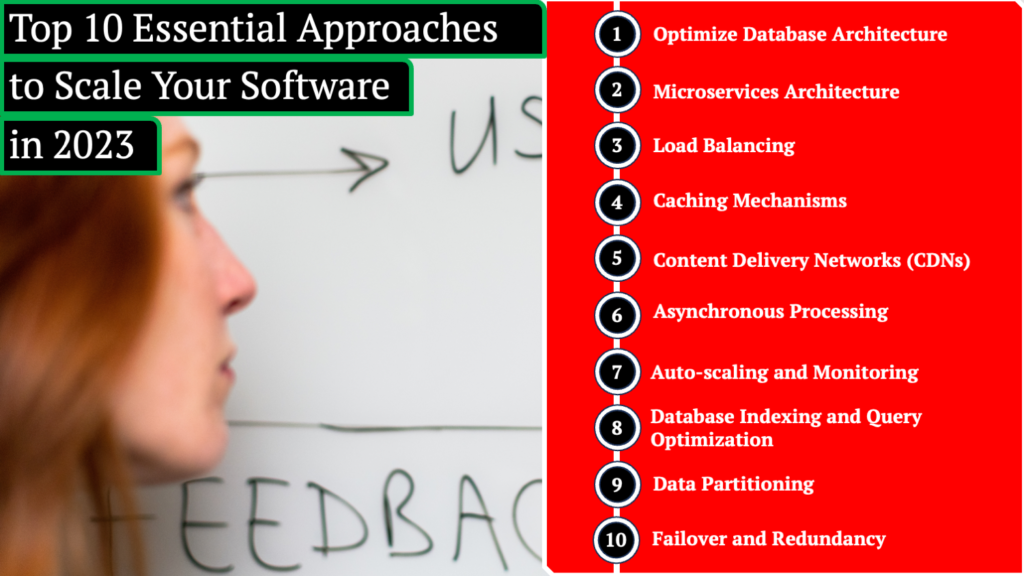To Share is to Show You Care!
In the fast-paced digital landscape of 2023, handling massive amounts of data and users is a challenge that every software developer must tackle. As technology evolves, so do the demands on software scalability. In this blog post, we’ll dive into effective strategies that will empower you to conquer data deluges and propel your software to new heights.
Key Strategies for Scaling Your Software

Optimize Database Architecture

Sharding Techniques: Divide data into smaller subsets and distribute them across multiple database servers. This reduces the load on individual servers and enhances query performance.
In-Memory Databases: Store frequently accessed data in-memory, minimizing the need to read from disk and drastically improving response times.
NoSQL Databases: Explore NoSQL solutions like MongoDB or Cassandra for horizontal scalability and flexible data models.
Microservices Architecture
Modular Design: Break down your application into independently deployable microservices. This enables teams to work on different components simultaneously.
Scalability Per Microservice: Scale specific microservices that experience higher demand, preventing resource wastage.
Containerization: Use technologies like Docker and Kubernetes to package and deploy microservices consistently, optimizing resource utilization.

Load Balancing

Even Traffic Distribution: Load balancers distribute incoming requests evenly among multiple servers, preventing any single server from being overwhelmed.
Horizontal Scaling: Add more servers to handle increased traffic during peak periods, ensuring a seamless user experience.
Vertical Scaling: Upgrade server resources (CPU, RAM) to accommodate higher user loads and more complex operations.
Caching Mechanisms
Caching Layers: Implement caching layers using tools like Redis or Memcached to store frequently used data, reducing database load and improving response times.
Cache Invalidation: Set up mechanisms to refresh cached data when it becomes outdated, ensuring users always receive accurate information.
Content Compression: Compress cached content to optimize storage usage and further enhance delivery speed.

Content Delivery Networks (CDNs)

Geographical Distribution: CDNs store static assets on multiple servers across various locations. Users receive assets from the nearest server, reducing latency.
Caching at Edge Servers: CDNs cache content at edge servers, reducing the load on your origin server and speeding up content delivery.
Traffic Spikes Handling: During traffic spikes, CDNs ensure your software remains accessible by managing increased demand efficiently.
Asynchronous Processing
Background Tasks: Offload resource-intensive tasks to background queues using systems like RabbitMQ or Kafka, preventing the main application from slowing down.
User Experience Enhancement: Asynchronous processing ensures that users aren’t kept waiting for operations that can take time, improving overall satisfaction.
Scalability: By handling tasks asynchronously, the application can scale more effectively to accommodate varying workloads.

Auto-scaling and Monitoring

Automated Scaling: Set up rules to automatically adjust the number of instances based on metrics like CPU utilization or request rate.
Real-time Monitoring: Employ monitoring tools like Prometheus or Grafana to track system performance and detect anomalies in real time.
Proactive Response: With auto-scaling and monitoring, your software can adapt to changing conditions and ensure optimal performance.
Database Indexing and Query Optimization
Index Selection: Choose appropriate columns to index based on query patterns. Indexes speed up data retrieval by reducing the need for full table scans.
Query Profiling: Analyze query performance using tools like EXPLAIN to identify bottlenecks and optimize slow queries.
Normalization and Denormalization: Strike a balance between normalized and denormalized data models based on query frequency and complexity.

Data Partitioning

Horizontal Partitioning: Divide large tables into smaller partitions based on specific criteria such as date ranges or geographical regions.
Query Performance: Partitioning can lead to improved query performance as the database system only needs to scan relevant partitions.
Maintenance Efficiency: Smaller partitions are easier to manage, optimize, and back up, enhancing overall system stability.
Failover and Redundancy
Failover Strategies: Implement failover mechanisms to redirect traffic to backup servers if the primary server fails, minimizing downtime.
Redundant Components: Have duplicate components (servers, databases) ready to take over in case of failure, ensuring uninterrupted service.
Load Balancing with Failover: Combine load balancers with failover mechanisms for seamless transition between healthy servers in case of failure.

Conclusion
Navigating the ever-evolving digital landscape requires a deep understanding of software scalability. By optimizing database architecture, adopting microservices, implementing load balancing, leveraging caching, utilizing CDNs, embracing asynchronous processing, implementing auto-scaling, optimizing database queries, partitioning data, and ensuring failover and redundancy, you can conquer data deluges and propel your software to new heights in 2023 and beyond. Remember, scaling is not just about handling more data and users—it’s about ensuring seamless experiences and unleashing the full potential of your software. So, gear up, embrace these strategies, and watch your software soar beyond limits! 🚀
Frequently Asked Questions
Q1: How do you scale an application for millions of users?
A: Scaling an application for millions of users involves implementing various strategies such as optimizing database architecture, adopting microservices, employing load balancing, caching mechanisms, utilizing content delivery networks (CDNs), and implementing auto-scaling based on user demand.
Q2: How do you handle a large-scale application?
A: Handling a large-scale application requires techniques like distributed architecture, load balancing, caching, asynchronous processing, and proper monitoring. Microservices, containerization, and efficient use of resources are also essential to ensure smooth performance and responsiveness.
Q3: How to design a system to scale to your first 100 million users?
A: Designing a system to scale to 100 million users involves using horizontal scaling, microservices architecture, optimized database design, caching, and asynchronous processing. Ensuring failover, redundancy, and utilizing CDNs are crucial to handle the increased load effectively.
Q4: How do you ensure scalability of software?
A: Ensuring software scalability involves strategies like designing for modularity, using scalable database solutions, adopting cloud technologies, optimizing code for performance, employing load balancing, and continuously monitoring and optimizing system resources.
Q5: How do you scale big data?
A: Scaling big data involves distributed computing frameworks like Hadoop and Spark, data partitioning, sharding databases, utilizing NoSQL databases, and employing techniques like data replication and data parallelism to handle the massive volume and velocity of data.
Q6: What is a highly scalable application?
A: A highly scalable application is one that can handle increased load and user demand without compromising performance. It can efficiently expand its capacity by adding resources or components while maintaining responsiveness and availability.
Q7: How do I make my application scalable?
A: To make your application scalable, focus on modular design, utilize microservices, employ load balancers, use caching and CDNs, optimize database queries, implement asynchronous processing, and incorporate auto-scaling based on traffic.
Q8: How can I improve the scalability of an application?
A: You can improve application scalability by optimizing database queries, implementing efficient caching mechanisms, adopting microservices, using content delivery networks (CDNs), employing horizontal and vertical scaling, and regularly monitoring and optimizing system performance.
Q9: What methods can you use for scaling applications?
A: Methods for scaling applications include horizontal and vertical scaling, database sharding, load balancing, microservices architecture, caching, CDNs, auto-scaling, and optimizing code and database queries.
Q10: How do you make a database scalable?
A: To make a database scalable, you can use techniques like database sharding, replication, distributed databases, caching, and optimizing queries. NoSQL databases are also often chosen for their scalability capabilities.
Q11: What are the scaling techniques for system design?
A: Scaling techniques for system design include load balancing, horizontal and vertical scaling, database partitioning, caching, microservices architecture, asynchronous processing, and using cloud services.
Q12: How do I make sure my system design is scalable?
A: To ensure your system design is scalable, focus on modularity, use appropriate database technologies, distribute the load efficiently, implement redundancy and failover mechanisms, and anticipate future growth when designing the architecture.
Q13: What are the two ways to achieve scalability?
A: The two ways to achieve scalability are horizontal scaling, which involves adding more machines to the system, and vertical scaling, which involves upgrading the existing hardware to handle increased load.
Q14: What are the three main components of scalability?
A: The three main components of scalability are performance scalability (handling increased load), availability scalability (ensuring continuous availability), and administrative scalability (managing the system as it grows).
Q15: What are the two most common options for scalability?
A: The two most common options for scalability are horizontal scaling (adding more machines) and vertical scaling (upgrading hardware resources on existing machines).
The Informed Minds
I'm Vijay Kumar, a consultant with 20+ years of experience specializing in Home, Lifestyle, and Technology. From DIY and Home Improvement to Interior Design and Personal Finance, I've worked with diverse clients, offering tailored solutions to their needs. Through this blog, I share my expertise, providing valuable insights and practical advice for free. Together, let's make our homes better and embrace the latest in lifestyle and technology for a brighter future.

